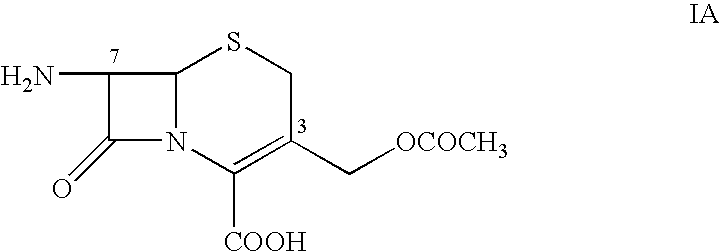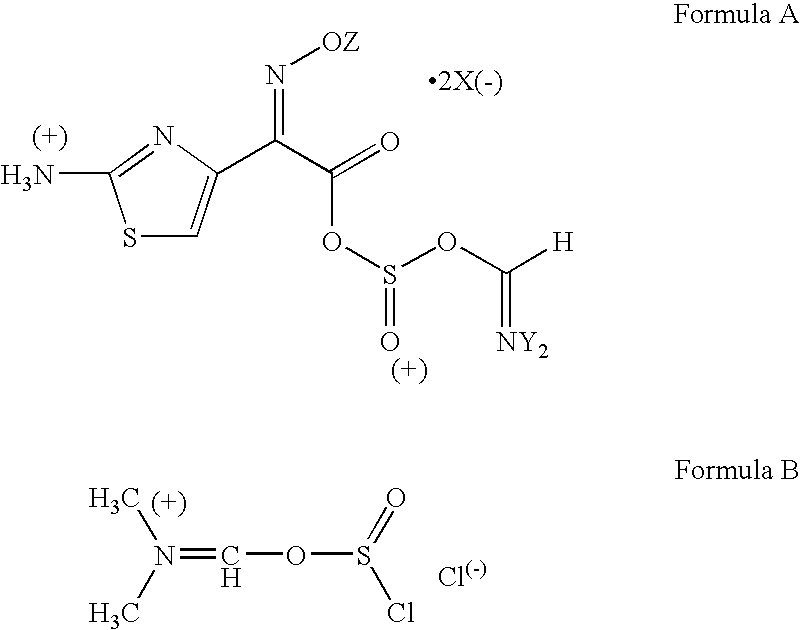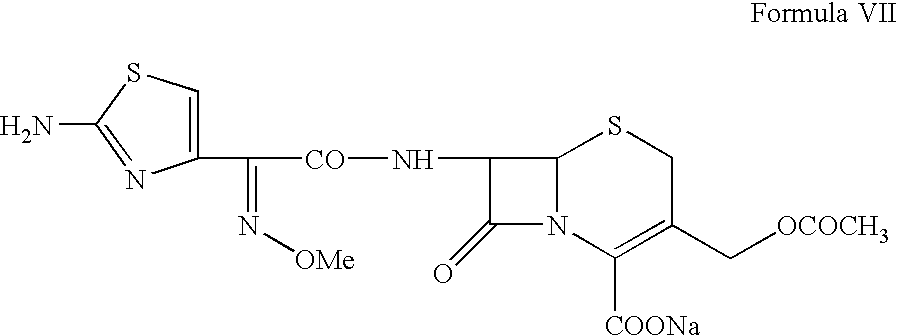Process for the production of cefotaxime sodium
a technology of cefotaxime and sodium, which is applied in the field of cefotaxime sodium production, can solve the problems of increasing the overall cost of cefotaxime preparation, and achieve the effect of high purity
- Summary
- Abstract
- Description
- Claims
- Application Information
AI Technical Summary
Benefits of technology
Problems solved by technology
Method used
Image
Examples
example 1
7-[2-(2-Chloroacetamidothiazol-4-yl)-2-syn-methoxyimino-acetamido]-3-acetoxymethyl-3-cephem-4-carboxylic acid (N-Chloroacetamido cefotaxime, V)
Step I: 2-(2-Chloroacetamidothiazol-4-yl)-2-syn-methoxyiminoacetic acid (II)
[0027] Chloroacetyl chloride (56.2 g) is added to a solution of 2-(2-aminothiazol-4-yl)-2-syn-methoxyiminoacetic acid (Formula I, 100 g) and 1000 ml of N,N-dimethyl acetamide at temperature of from −5° C. to 5° C. The temperature of the reaction mixture is gradually increased to from 30° C. to 35° C. and stirred until the disappearance of the starting material. After the reaction is complete, the mixture is poured into 1000 ml of cold water at 5° C. and stirred allow the product to precipitate. The precipitate obtained is filtered, washed with water, and dried under vacuum to provide 2-(2-chloro-acetamidothiazol-4-yl)-2-syn-methoxyiminoacetic acid (Formula II).
Step II: 2-(2-Chloroacetamidothiazol-4-yl)-2-syn-methoxyiminoacetyl chloride (III)
[0028] Phosphorus penta...
example 2
7-[2-(2-Aminothiazol-4-yl)-2-syn-methoxyiminoacetamido]-3-acetoxymethyl-3-cephem-4-carboxylic acid (Cefotaxime acid, VI)
[0030] 7-[2-(2-Chloroacetamidothiazol-4-yl)-2-syn-methoxyiminoacetamido]-3-acetoxy-methyl-3-cephem-4-carboxylic acid (Formula V) (wet product from Step III of Example 1), thiourea (50 g) and sodium carbonate (40 g) are suspended in a mixture of 200 ml water and 400 ml of isopropyl alcohol at a temperature of from 20° C. to 30° C. Sodium carbonate is added to the reaction mixture to obtain a clear solution. The progress of the de-protection of the chloroacetyl group is monitored by HPLC. After completion of the de-protection reaction, the crude solution is decolorized with active charcoal and filtered. The pH of the filtrate is adjusted to from 2.7 to 3.0 with dilute hydrochloric acid, at temperature of from 20° C. and 30° C. to provide a precipitate of Cefotaxime. The reaction mixture is stirred for an additional 2 hours, filtered, washed with isopropyl alcohol, a...
example 3
Sodium, 7-[2-(2-aminothiazol-4-yl)-2-syn-methoxyimino-acetamido]-3-acetoxymethyl-3-cephem-4-carboxylate (Cefotaxime sodium, VII)
[0031] Cefotaxime acid (Formula VI, 100 g) prepared in Example 2 is suspended in a mixture of 300 ml methanol and 200 ml ethyl acetate followed by addition of triethyl-amine (28.8 g) at a temperature of from −5° C. to 5° C. The solution obtained is treated with activated charcoal (10 g) and filtered. A solution of sodium-2-ethylhexanoate (60 g) in 400 ml ethyl acetate is added to the colorless filtrate at a temperature of from −5 to 5° C. The Cefotaxime sodium is precipitated by diluting the reaction mixture with additional ethyl acetate. The slurry containing the Cefotaxime sodium is filtered, washed with cold ethyl acetate and dried under vacuum to obtain a white material having HPLC purity more than 99%, without any impurity greater than 0.1%.
PUM
| Property | Measurement | Unit |
|---|---|---|
| temperature | aaaaa | aaaaa |
| temperature | aaaaa | aaaaa |
| temperature | aaaaa | aaaaa |
Abstract
Description
Claims
Application Information
 Login to View More
Login to View More - R&D
- Intellectual Property
- Life Sciences
- Materials
- Tech Scout
- Unparalleled Data Quality
- Higher Quality Content
- 60% Fewer Hallucinations
Browse by: Latest US Patents, China's latest patents, Technical Efficacy Thesaurus, Application Domain, Technology Topic, Popular Technical Reports.
© 2025 PatSnap. All rights reserved.Legal|Privacy policy|Modern Slavery Act Transparency Statement|Sitemap|About US| Contact US: help@patsnap.com



